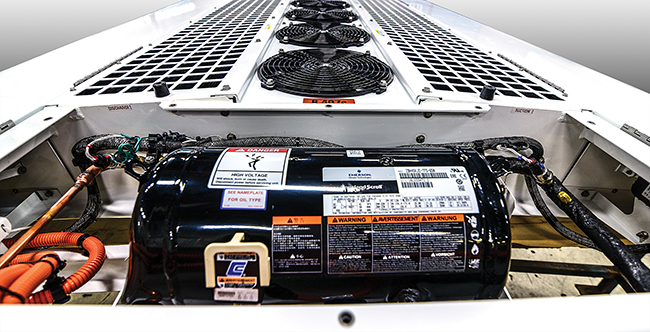
By Steve D. Johnson
By now you know that certain components like mechanical compressors, clutches, belts, hoses and fittings will go away with the all-electric HVAC. These will be replaced by electrically-driven components and lead to the most important change technicians will see, exposure to high voltage. For the end user, technicians will have to be properly trained, and perhaps even certified to service these high voltage systems. For the suppliers, it means proper marking and warnings, detailed service procedures, and, most importantly, a safe environment for servicing and reliable safety disconnect systems. Couple the HVAC and the all-electric battery bus with its own (and even more complex) high voltage systems, and it is easy to see that maintenance as we know it will experience quite an extensive transformation.
While training and most likely certification will be required to service the new systems, and will demand some investment from the end user, there are some tremendous benefits as a result of this major step change. Consider the items that go away and the time and cost associated with checking, diagnosing and replacing parts. A simple and easy-to-understand example is the mechanical compressor, and the clutch, belts, hoses and fittings that need to be checked every 6,000 miles on a conventional system. With an all-electric HVAC, they aren’t there to be checked, or to fail.
 So, what maintenance is required for the all-electric HVAC? As with the conventional HVAC, the all-electric HVAC requires a visual and running check each day before it goes on the route. The 6,000-hour inspection includes only an air filter change unless the technician sees or hears something unusual, which may occasionally be the case. The best way to ensure that your all-electric HVAC will run trouble-free during the cooling season is to do a thorough and comprehensive pre-season inspection just as many of us do with our home HVAC unit. A pre-season inspection should cover the following:
So, what maintenance is required for the all-electric HVAC? As with the conventional HVAC, the all-electric HVAC requires a visual and running check each day before it goes on the route. The 6,000-hour inspection includes only an air filter change unless the technician sees or hears something unusual, which may occasionally be the case. The best way to ensure that your all-electric HVAC will run trouble-free during the cooling season is to do a thorough and comprehensive pre-season inspection just as many of us do with our home HVAC unit. A pre-season inspection should cover the following:
Pre-Run Inspection: (Note: Do items 2, 5, 6, 8 and 9 every month or 6,000 miles.)
1. Inspect and wash evaporator and condenser coils with warm soapy water. Rinse thoroughly. High pressure recommended.
2. Insure that drain lines are clear and that the drain outlet check valves are in place.
3. Inspect evaporator, condenser and compressor motor-mounting hardware. Ensure that all is tight and in
good condition.
4. Check fans and blowers to ensure all turn freely without interference or noise.
5. Visually inspect electrical connections and wiring for corrosion and chafing. Clean and/or repair as necessary.
6. Inspect all electrical panels, terminal boards, and contactors in and out of the control box for signs of arching, heat or loose connections.
7. Re-torque all contactor wire mounting hardware per the torque specifications in the service manual. If dirt or lint is present, clean with a nylon brush and spray with contact cleaner as needed. Check cover for proper seal. Replace any missing hardware.
8. Inspect all refrigerant connections for signs of oil residue. (Oil residue usually indicates a present or past refrigerant leak.) Clean and note location on inspection sheet for immediate attention.
9. Replace return air filter(s).
Running Inspection: (Note: Do items 1 and 2 every month or 6,000 miles.)
1. Start bus and run the HVAC in the full cool mode. The set point may need to be adjusted down or the unit may need to run in the heat mode for a short time to simulate a load on the evaporator. An ambient temperature above 70 degrees Fahrenheit works best.
2. Listen for any unusual noises or vibration. If present, identify and take corrective action.
3. Continue to let the bus and HVAC system to run if no issues were identified. Check the liquid line sight glass for bubbles. Using the controller key pad, access system pressures. Record pressures, ambient and interior temperatures.
We should highlight at this point that items 5, 6, and 7 on the pre-run inspection list is where the technician will be working in a high voltage environment and precautions should be taken. Also worth noting is the difference between the all–electric HVAC maintenance schedule and the conventional system schedule is a 50% reduction in labor hours, which does not take into account the parts that are not there and will never need to be replaced. While little mention is made of maintenance savings in the energy efficiency and sustainability discussion, it is certainly an important element of the all-electric value proposition.
Steve D. Johnson, Sr. serves as product marketing manager, Bus HVAC, at Thermo King, Minneapolis, MN. Thermo King is a world leader in transport temperature control systems for buses. Thermo King also manufactures auxiliary power units, which dramatically reduce engine idling. All Thermo King products are backed by a nationwide dealer network.
